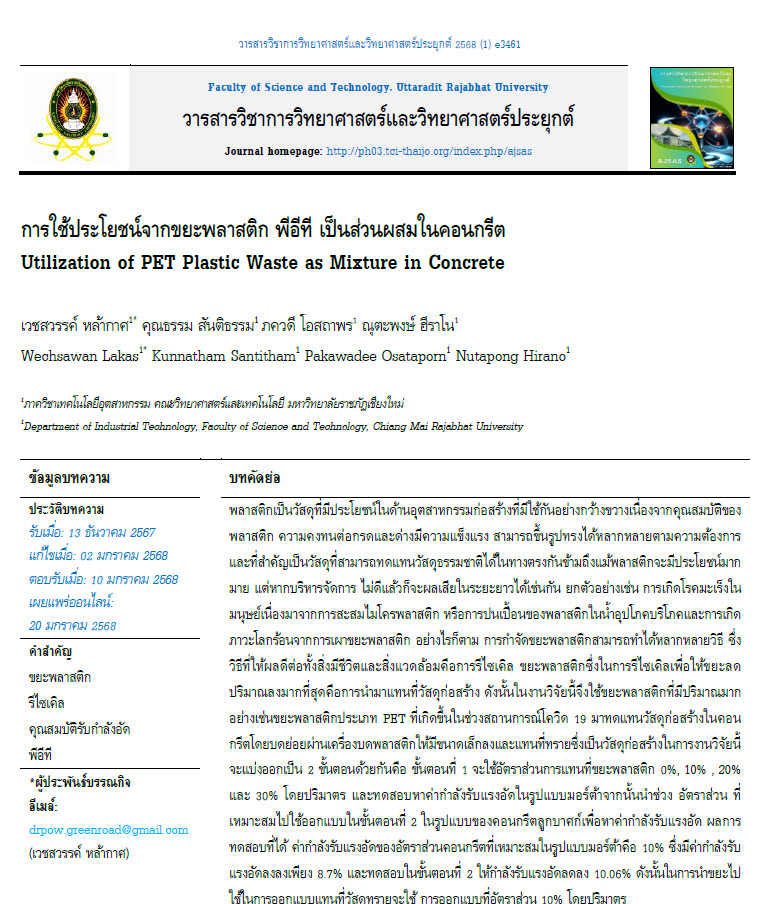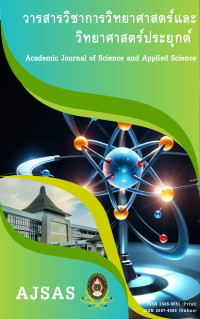Utilization of PET Plastic Waste as Mixture in Concrete
Keywords:
Plastic Waste, Recycle, Compressive Strength, PETAbstract
Plastic is a versatile and durable industrial material that can be molded into various shapes, making it a suitable replacement for natural materials in many applications. Despite its benefits, improper management of plastic waste has led to significant environmental challenges. Plastics take over a century to decompose, and incomplete decomposition results in microplastics, which harm ecosystems and living organisms. Among the many disposal methods, reusing and recycling plastics are the most sustainable options. Recycling not only reduces environmental impact but also adds economic value by converting waste into useful products such as building materials. This need for effective recycling has become especially urgent, as the COVID-19 pandemic resulted in a drastic increase in plastic usage over 300% due to remote work and higher reliance on plastic products.
This research focuses on utilizing PET plastic waste as a partial substitute for sand in concrete, aiming to combine waste management with sustainable construction. The study explores the replacement of sand with PET plastic in proportions of 0%, 10%, 20%, and 30%, followed by mortar and concrete compressive strength tests to determine the optimal mix. Results reveal that replacing 10% of sand with PET plastic yields the best balance between sustainability and structural performance, causing only an 8.7% reduction in mortar strength and a 10.06% reduction in concrete strength. These findings demonstrate that PET plastic waste can effectively be repurposed as a building material, offering a practical solution to mitigate plastic pollution while supporting eco-friendly construction practices.
References
Pilapitiya, N. T., & Ratnayake, A. S. (2024). The world of plastic waste: A review. Cleaner Materials, Elsevier, (11), e100220. Retrieved From https://jouranals.elsevier.com/cleaner-materials https://doi.org/10.1016/j.clema.2024.100220
Plastics Europe Association of Plastics Manufacturers. (2018). Plastics - the Facts 2017. Avenue E. van Nieuwenhuyse 4/3 1160 Brussels – Belgium.
บุญชนิต ว่องประพิณกุล และ สุจิตรา วาสนาดารงดี. (2564). ขยะพลาสติกจากการสั่งอาหารออนไลน์สถานการณ์ปัญหาและ แนวทางแก้ไข. สิ่งแวดล้อม, 25(1),
Verma,R.,Singh,S.,&Choudhary,M.(2016). Toxic pollutants from plastic waste - A review. Procedia Environmental Sciences, 35, 701-708. https://doi.org/10.1016/j.proenv.2016.07.069
Tsuchimoto, I. and Y. Kajikawa. (2022). Recycling of Plastic Waste: A Systematic Review Using Bibliometric Analysis. Sustainability 14(24), e16340. https://doi.org/10.3390/su142416340
ธงชัย ทองมา, ธีระวัฒน์ จันทึก และจิตราวดี รุ่งอินทร์ กันกา. (2564). การเพิ่มมูลค่าผลิตภัณฑ์ชุมชนจากขยะเหลือใช้สู่ การจดสิทธิบัตรการประดิษฐ์โดยการมีส่วนร่วมของกลุ่มผู้สูงอายุ และชุมชน กรณีศึกษา ตำบลคลองโยง อำเภอพุทธมณฑล จังหวัดนครปฐม. วารสารวิชาการการตลาดและการจัด การมหาวิทยาลัยเทคโนโลยี ราชมงคลธัญบุรี, 8(1), 1-10.
Lumina, P., Pallavi, G A., Bhavya, C H., Vanishree, S., & Supriya, C B. (2022, June, 8-9). Use of waste plastic as fine aggregate substitute in concrete. IOP Conference Series: Materials Science and Engineering. Bengaluru. India. 1255(1), 012010. https://doi.org/10.1088/1757-899X/1255/1/012010
เวชสวรรค์ หล้ากาศ. (2018). การประยุกต์ใช้ถนนแอสฟัลต์
คอนกรีต เพื่อลดปัญหาขยะพลาสติกในชุมชน : กรณีศึกษา
ถนนทางเข้าวัดแม่ สาหลวง จังหวัดเชียงใหม่. วารสารวิทยาศาสตร์ มข, 46(4), 812-821.
Batayneh, M., Soroushian, P., & Fayad, M. (2007). Use of selected waste materials in concrete mixes. Waste Management, 27(12), 1870-1876.
Belmokaddem, M., Mahi, A., Senhadji, Y., & Pekmezci, Y. (2020). Physical and Mechanical Properties of Concrete Containing PVC Waste as Aggregate. In Senhadji, Y. (Eds.), Proceedings of the 4th International Symposium on Materials and Sustainable Development. 48-56. https://doi.org/10.1007/978-3-030-43211-9_5
ASTM International. (2001). ASTM C 136 – 01:Sieve Analysis of Fine and Coarse Aggregates. ASTM International. https://cdn.standards.iteh.ai/samples/1554/242c3c8a36ab47f1b436b8741a368b09/ASTM-C136-01.pdf.
American Society for Testing and Materials. (2001). ASTM C 39-01: Standard Test Method for Compressive Strength of Cylindrical Concrete Specimens. ASTM International. https://doi.org/10.1520/C0039_C0039M-99
สำนักวิเคราะห์ วิจัยและพัฒนา กรมทางหลวงชนบท. (ม.ป.ป.). มทช. 101-2561 มาตรฐานงานคอนกรีตและคอนกรีตเสริมเหล็ก. https://drive.google.com/file/d/1Fuvd3Bc6oSPpvk-JVLXRrRJNHCt2dJni/view
British Standard Institution. (1970). BS 1881:Part 3. Testing Concrete part 3 Methods for analysis of hardened concrete. British Standard House.
Haach, V. G., Vasconcelos, G., & Lourenço, P. B. (2011). Influence of aggregates grading and water/cement ratio in workability and hardened properties of mortars. Construction and Building Materials, 25(6), 2980–2987. https://doi.org/10.1016/j.conbuildmat.2010.12.034 [16] Zainab Z. Ismail,Z., Enas A., & AL-Hashmi. (2008). Use of waste plastic in concrete mixture as aggregate replacement. waste management, 28(11),2041–2047 https://doi.org/10.1016/j.wasman.2007.08.023.

Downloads
Published
How to Cite
Issue
Section
Categories
License
Copyright (c) 2025 Academic Journal of Science and Applied Science

This work is licensed under a Creative Commons Attribution-NonCommercial-NoDerivatives 4.0 International License.


